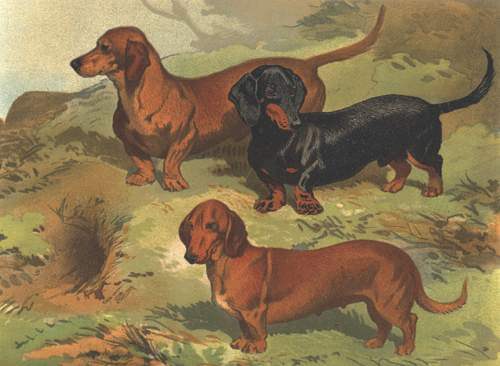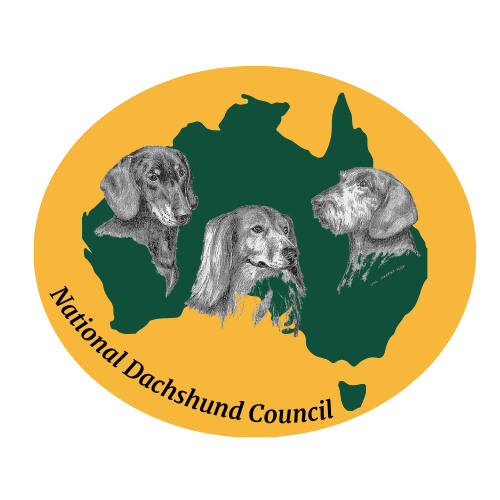History of the Dachshund Breed Standard in Australia
If you ask an experienced Dachshund breeder about the ideal type of Dachshund most will say that a good Dachshund is one that is moderately long and low with no exaggeration, has a strong jaw, has a reasonably level top line, strong bones, good length of ribbing, strong breastbone, bold defiant and intelligent expression, true movement driven from the hindquarters etc.
Over many years the ideal points of a Dachshund have been influenced by two main areas, the Working Dog and the Show Dog. The modern Dachshund was originally bred in Germany as a Working Dog to hunt wildlife such as badgers, foxes, stoats, rabbits and rats. It was required to go to ground and flush out prey but as the Dachshund became increasingly versatile it was also used to flush out prey from long grass and scrub land.
Size Variations
There were two basic sizes developed. These were the standard size and the miniature size. There is now a third even smaller size called a “Kaninchen”, this is referred to as a “Rabbit Dachshund” in Australia. The standards hunted the larger wild life such as badgers, stoats & foxes and the miniatures were ideally suited to hunting rabbits and rats. Since the end of the Second World War, Dachshunds have been bred mainly for the Show Ring. Many though, have been successful in Obedience and Earth Dog Trials.
The original Dachshunds were the smooth haired type but during the eighteenth and nineteenth centuries the long haired and wire haired types started to appear as Dachshunds were bred for different hunting requirements. In the early days the standard Dachshund was mostly in the majority, especially the smooth haired variety, which was considered by the experts to be the pure-bred Dachshund. However, in the 1920’s the wire haired Dachshund became very popular but the long haired variety remained the favourite for many years.

Breed Standards
As breeding Dachshunds became popular, breed standards were introduced. It is unclear when the breed standards were developed. There was an original German system of illustrating the Dachshund’s standard of points in their stud books. In Europe, Dachshunds have their own group within the FCI Breed Standard. In the United Kingdom it may have been because of the unpopular Great War with Germany from 1914-1918 that the UK breed standard was developed. It has been reported that the Dachshund became unfashionable after the Great War because of its association with Germany.
In 1939, John F Sayer developed The Illustrated Standard of Points of the Dachshund of all varieties. It was developed to help beginners to breeding in the art of breeding to type. He stated that all varieties are governed by the same anatomical rules of construction, though differing in the texture of their coats. He also said that it is possible to breed a good show dog that with proper training may become an accomplished worker. John F Sayer’s book has become the Bible for Dachshund breeders from the point of view of its very good illustrations and text and will be found in every Dachshund breeder’s library.
The Kennel Club (UK) adopted six written standards describing all six varieties of the Dachshund that are recognised there (they do not include the Kaninchen). It is true that each standard is based on the requirements of a standard smooth haired Dachshund but over time each standard had become slightly different in various criteria. Today, we refer to this standard as the “Pre-1987” Standard.
The Pre-1987 Standard
Until 1992, it was the Australian National Kennel Council policy to adopt only The Kennel Club (UK) Standards. In 1987 the Kennel Club (UK) urged all English Breed Clubs to revise their Standards. This was completed in 1994. The revised 1994 Kennel Club (UK) standard brought all six varieties under the one Standard and very similar in description to the Pre-1987 Standard and J.F. Sayer’s excellent book. Sometime after 1994, the ANKC agreed to allow Australian Breed Clubs to choose between the Pre-1987 Standard, the revised 1994 Kennel Club (UK) Standard, the FCI Standard or the Country of Origin/Development Standard.
In 1996, National Dachshund Council (Australia) member clubs voted on which Standard they would prefer. The choices were between a Proposed Australian Standard, the Pre-1987 Standard, the revised 1994 Kennel Club (UK) Standard or the FCI Standard. The Australian member clubs voted for a Proposed Australian Standard as their first choice and the revised 1994 Kennel Club (UK) Standard as their second choice. The ANKC subsequently, notified the National Dachshund Council (Australia) that a Proposed Australian Standard was not an option.
Therefore the revised 1994 Kennel Club (UK) Standard automatically became the Australian member club’s Standard of choice. The ANKC procedure for changing from the Pre-1987 Standard to the revised 1994 Kennel Club (UK) Standard was never completed. Consequently, until 30 June 2009 in Australia we followed the Pre-1987 Standard.
The Pre-1987 Standard was the reference for many experienced breeders in Australia with additional references from J F Sayers book and lecture notes documented by Mrs. J Reading who was a very skilled Dachshund breeder in Australia during the 1960’s and 1970’s. In July 2009, the Kennel Club (UK) adopted a new revision of the 1994 Standard which has additional guidelines to help improve the Health & Welfare of the Dachshund breed.
The Kennel Club (UK) Dachshund Standard
Early in 2008, the National Dachshund Council (Australia) notified the ANKC of member clubs request to change to the current Kennel Club (UK) Dachshund Standard. In February 2009 the ANKC published a survey asking all owners of Dachshunds who were members of their State Canine Control Councils to vote on whether they wanted to change from the Pre-1987 Standard to the current Kennel Club (UK) Standard. There was a lot of interest generated by this request and like in any democratic debate there were very strong views and discussions on the pros and cons of the proposed change. Dachshund owners were given until March 31st 2009 to cast their vote Yes or No. Some owners felt that this amount of time was too short but a large number of votes were received and counted and the Yes vote was carried by a comfortable margin.
The current Kennel Club (UK) Dachshund Standard came into effect in Australia on the 1 July, 2009. It was updated in June 2012.
Because the new Standard is still only a written description of the breed the National Dachshund Council (Australia) has developed a Breed Standard Extension which documents the 2009 Kennel Club (UK) Dachshund Standard and additionally contains the pictorial diagrams from J F Sayer’s book, Mrs. J Reading’s lecture notes, The Show Dachshund & History of Correct Movement by Robert Cole & Dr Sylvia Kershaw and Back to Basics Article by Jeffrey Crawford. This Breed Standard Extension is published on the ANKC website. It serves as a curriculum for Judges Training Programs, and is an invaluable reference for Dachshund Breeders and Dachshund Judges in Australia.
